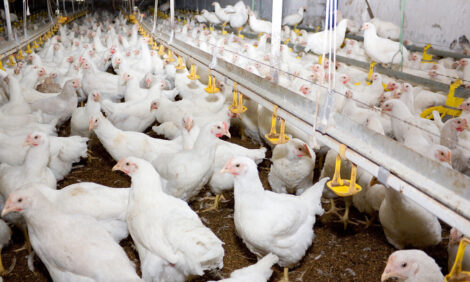



How Will UK Meat Exports Face Challenges Following EU Exit Vote?
ANALYSIS - The UK’s meat and livestock industry can expect more volatility in the wake of the referendum vote to leave the EU, writes Chris Harris.Speaking at the Agricultural and Horticultural Development Board’s Meat Export Conference, AHDB CEO Jane King said the decision to leave the EU was a “game-changer” for UK farming and growing.
She said the Brexit vote will open up four areas for question for the agricultural and horticultural industries - trade, regulation, labour and support.

“Huge uncertainty hangs over these while the UK negotiates its departure from the EU, the most immediate and pressing challenge being to determine what relationship might be entered into in terms of access to the EU single market,” said Ms King.
She added: “Though the importance of the EU single market cannot be understated for UK food businesses, we already have a strong track record in market development outside the EU, having successfully worked with Defra and UKTI to secure market access to China for UK barley and pig meat and India for seed potatoes.
“This area of work will become ever more important once Brexit takes effect.
“The industry should clearly be braced for more volatility in currency, inputs prices and commodities markets as the nature of our new relationship with Europe emerges.”
Ms King said that the AHDB will be helping its levy payers become more competitive and sustainable in the current market situation and it will make helping the industry and government secure the best trading environment for UK agriculture, food and horticulture inside and outside the EU a priority.
UK "well positioned" for years of uncertainty
Jean Pierre Garnier, head of AHDB livestock exports told the conference that there would be three years of “rough seas and uncertainty” ahead for the UK meat trade facing the challenges of tariff and non-tariff barriers.

However, he said that the UK was well positioned and should have a positive future for exports across the board both to the EU and outside the EU.
At present 32 per cent of the UK’s pig meat production is exported with last year 70 per cent going to the EU.
For beef 18 per cent of production is exported, with 92.5 per cent going to the EU and for lamb with 37 per cent of production exported, 96.4 per cent goes to the EU.
Mr Garnier said that UK meat, livestock and dairy product exports this year are expected to reach £3.6 billion.
And he added that it is essential that “livestock products are high on the agenda in future EU and FTA negotiations and not sacrificed in the bargaining.
“Adequate resources must be provided from Government regarding negotiations on SPS, tariffs, non-tariff barriers and renegotiations of Export Health Certificates,” he said.
“AHDB has expertise in this field and is ready to support Government efforts in this field.
“New export food marketing policy and support are needed from Government to relieve market difficulties likely to arise and the full economic and policy implications must be evaluated.”
He added: “Export does not work in a vacuum.”
He said that there was some naivety about free trade agreements and warned of the dangers of tariffs such as those imposed by Norway on lamb carcases of 429 per cent and by Thailand on poultry meat products of 50 per cent where the UK imports chicken from Thailand tariff-free.
“We need to fight our corner and non-tariff barriers are as important as tariffs,” he said.
Market pressures need to be considered
Mr Garnier said that some of the key issues that will have to be considered as the trade negotiations take place will be that deflationary pressure is still affecting the EU and world’s beef, pork and poultry markets.
He said that the price of fifth quarter products is still very low, particularly for sheep skins.
The immediate drop in the value of sterling against the Euro and the dollar have also had an immediate impact on the price of exports.
The difference of price between Irish and British beef has reduced.
Mr Garnier said that the trend for UK meat and livestock product exports is rising, but the UK has to differentiate itself by developing a service culture, because UK meat products are expensive.
He said the UK meat industry had to develop the eating experience and consistency of the product and ensure effective presentation and packaging as well as promoting the products through the story of quality production and rearing.
Mr Garnier said that pork exports are doing well, particularly to the USA, India and the Philippines.
In 2016, exports including processed pork products and live equivalent, will account for a record 32 per cent of UK production, worth £ 390 million.
However, China is the important market, where the country is seeing falling production, down by about 7.9 per cent this year and high domestic prices attracting exports.
This scenario is expected to continue into next year.
In the pig meat sector, the UK is still dependent on the EU for exports and he said there is great potential for the UK to continue in this market by satisfying a growing demand for high welfare, antibiotic free product from countries such as the Netherlands, Sweden and Germany as well as Australia, the US, Japan and China outside the EU.
Another area for development in the export market is through e-commerce, particularly in Asia in China, India, Japan and South Korea.
In Korea, internet food sales are expected to increase from three to 11 per cent of total food retail sales between 2016 and 2020 and in China, 13 per cent of all Chinese retail sales already take place over the Internet.
More than 90 per cent of Indian internet buyers buy food using a smartphone, 55 per cent of Chinese internet food buyers.
In the beef sector, Mr Garnier said that beef exports are starting to rebound.
Exports for 2013-15 were hit by a combination of high prices and high currency, but so far this year, beef exports are up by 18.5 per cent and further progress should continue.
However, he warned that there is also a deflationary environment that could affect the market.
UK beef to be promoted in premium markets
The traditional markets, mainly in the EU dominate UK beef exports with the list headed by Ireland, the Netherlands and France, but the nature of the exports is changing from carcases to boned chilled cuts, offering added value.
Mr Garnier said that a new initiative is being launched to boost beef exports to premium markets.
“We need to step up our efforts to promote English beef as a premium product able to compete against the best,” he said.
“We are proposing to create a small guild of premium beef processors.
“We will create new branding and new high quality marketing material for premium English beef with consistent high eating experience.
“We will be targeting mainly food service in premium markets e.g. Germany, Scandinavia, The Netherlands, Hong Kong."
The campaign is expected to be launched in the autumn.
Lamb demand strong
In the lamb sector, exports are expected to be around 300,000 tonnes this year, 39 per cent of production with the majority going to France.
Mr Garnier said that there had been a fall in exports in 2015 to Hong Kong, France, and Norway because of low price competition from Spain in Southern France and Italy and the low value of ovine fifth quarter.
However, there has been progress in market penetration in Europe and relations with major European retailers has been building and the UK is seeing a rise in cut sales and value added.
European demand, with the exception of France, Spain and Greece, is generally good, Mr Garnier said, and it will be boosted by the end of overvaluation of Sterling.








